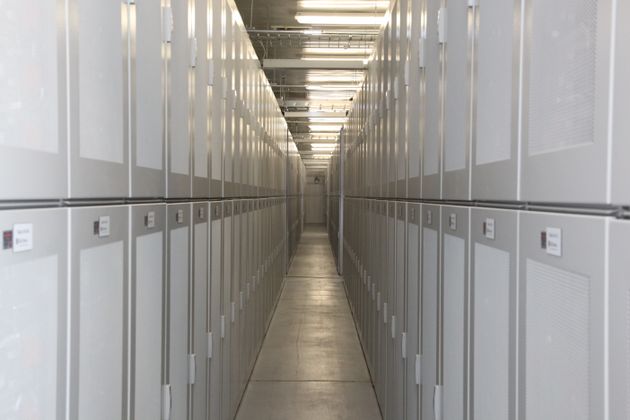Quarry Battery, a new pumped storage plant for North Wales
Electricity is expensive to store in large quantities. The largest battery pack in North America has just opened this week at a cost of about $50m for 32 MWh of lithium-ion cells. That’s over $1,500 a kilowatt hour, several times the cost of batteries in electric cars. (I presume the reason for the high cost must be the sophisticated electronics necessary to tie the DC battery system to the local grid). The new plant is sited at one of the substations serving the huge Tehachapi wind farms in Southern California. 600,000 individual batteries wired together in a 500 square metre warehouse are helping to stabilise the output of the five thousand turbines in this important wind province.
The UK’s largest storage battery is being built in Leighton Buzzard, north of London, and is due for completion by the end of 2014. This 10 MWh plant is costing about £20m, partly paid by Ofgem and partly by the local operator UK Power Networks. The cost is over twice the price per kilowatt hour of the Californian battery.
Adding the gigawatts/gigawatt hours of short term storage that we need is going to cost huge sums. Batteries will get cheaper, of course, particularly if Tesla continues to invest in enormous factories in the US. But even at $250 per kilowatt hour of storage capacity – one estimate of the likely cost of Tesla batteries within a few years - a gigawatt hour will require expenditure of $250m. That buys the capacity to store about a minutes worth of UK peak electricity need.
One alternative to lithium-ion batteries is an expansion of pumped hydro. Two water reservoirs at different heights are linked and reversible turbines are installed. When electricity is cheap, water is pumped uphill to the top reservoir. At times of high power demand the water flows back downhill, turning the turbines and producing electricity. The UK has had a large pumped hydro plant at Dinorwig in Snowdonia for thirty years.
A new company, Quarry Battery, has just raised another round of seed money to push its own Snowdonia project forward. £3m will enable the company to carry out engineering costings and other preparatory tasks for its scheme to turn two disused deep slate quarries into the upper and lower reservoirs of a pumped hydro plant.
Quarry Battery has planning permission for its two sites at Glyn Rhonwy near Llanberis. It will eventually need to raise about £135m to construct the system and will gain a capacity of about 600 MWh of electricity storage. The maximum rate of generation is intended to be about 50 MW, or the equivalent of a 25 turbine wind farm working at full speed. This means that when full the top reservoir can discharge for 12 hours.
The figures for the projected cost show the relatively attractive position of the best pumped hydro sites compared to lithium ion batteries. At less than £250 per kilowatt hour of storage capacity, Quarry Battery will deliver power at about a quarter the capital cost of Tehachapi. Quarry Battery is keen to emphasise that the costs for the Glyn Rhonwy are low because the two quarries are already fully excavated but no longer used. Most other potential sites will be far more expensive to develop.
Does Glyn Rhonwy make good financial sense? Modelling the economics is difficult and I’m not sure what the answer is. We can get one idea by looking at the daily price differences in the UK electricity market know that one simple trading tactic is to pump water uphill when power is cheap and letting it out when prices are better.
On Sunday and Monday 28/29th September, the UK’s pumped storage stations, including Dinorwig, were using power from about 10.30 pm at night to about 7pm on Monday morning to pump water uphill. The rest of the time the water stored in the upper reservoir was being used to generate electricity by letting it flow downhill. If Glyn Rhonwy copied this, it will probably be buying electricity at around £30 per MWh and selling at about £60. The company claims the overall efficiency of the round-trip is around 80%.
So if Glyn Rhonwy did nothing else but fill and empty 600 MWh worth of water every day it would earn
600 MWh * (£60-(£30/0.8) * 365 days a year = c. £4.9m a year.
But other services are potentially much more valuable. Holding Quarry Battery ready so that it can respond to major price variations may be a better strategy. German power prices now often move below zero at times of high wind or solar output and this pattern is likely to be repeated here. Waiting opportunistically to be paid to fill up the upper reservoir may be a good tactic.
Or it may make sense to keep the top reservoir full to meet emergency power needs. One observer recently told me that as conventional coal and gas plants are turned on and off more frequently to complement varying wind (and increasingly solar) power, they are becoming less reliable and sometimes fail to start up properly. Quarry Battery could earn good money from standing ready at 8am as power demand rises waiting to respond to the very high prices that are available when the plants that were expected to provide power fail to do so.
The company is understandably coy about revealing its own detailed estimates of income but did say that it expected the sources of annual income in the following table. About half its revenue, it said, will come from the Balancing Mechanism and half from the other sources.
| Type of income | Explanation |
| ‘Balancing mechanism’ | Income from responding to urgent requests to take power or to provide it in order to balance the Grid |
| Arbitrage income | Buying when power is cheap and selling it when it is expensive |
| ‘Triad’ payments | Payments from the local network operator (Scottish Power) for reducing the peak power needs for North Wales from the National Grid |
| ‘Capacity mechanism’ | Payments for being ready to provide power at short notice. (Not to be confused with actually providing power). |
As the UK grid becomes more stressed in the decades to come, Quarry Battery’s services will become increasingly valuable. The company projects that it will earn a financial payback in about 15 to 25 years. Glyn Rhonwy will last many decades, so the relatively slow returns will not necessarily impede its financing.
Dave Holmes, the Managing Director of the company, stresses that Quarry Battery looked across the entire country for the best locations for a pumped storage plant. Glyn Rhonwy was chosen because of the favourable conditions in the old slate-producing area. ‘We are lucky on this site', he said, 'as the civil (engineering costs) are vastly reduced by the suitable geology, topography and existing cavernous disused quarries’.
The UK needs fifty or a hundred times as much as storage capacity as Glyn Rhonwy can provide. The worrying thing is that if this excellent site needs at least 15 years to pay its investors back very few other places will meet the conditions for commercial funding. And if Leighton Buzzard is any guide, lithium-ion batteries don’t offer much help either.

